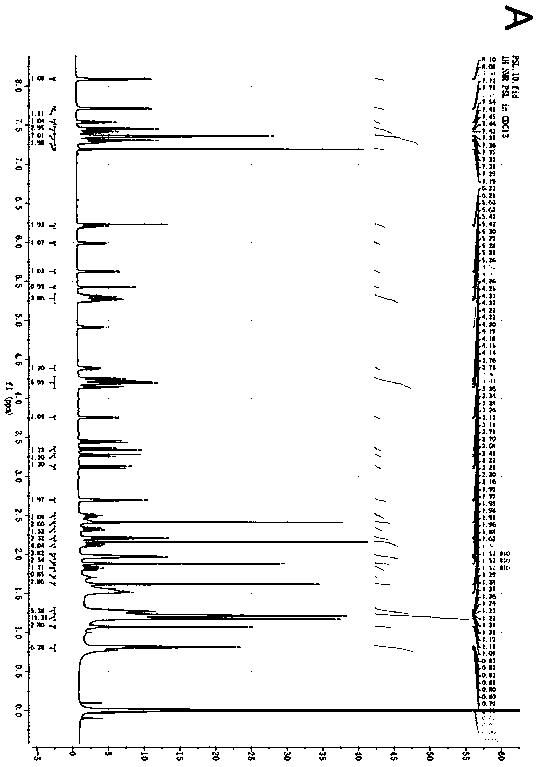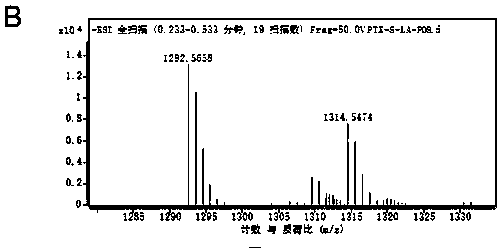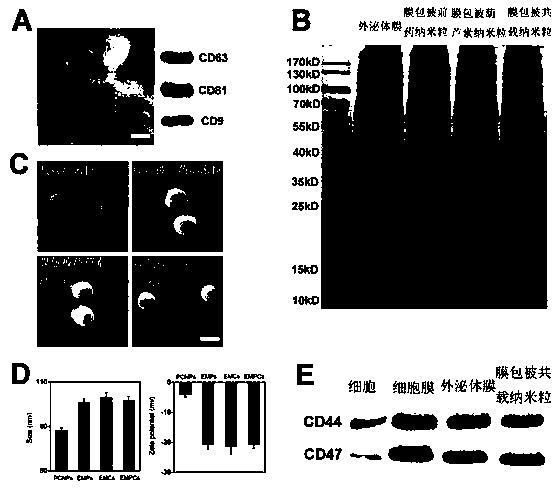Cucurbitacin B and oxidation-responsive antitumor prodrug co-loaded bionic nanoparticle
A technology of biomimetic nano and anti-tumor drugs, applied in the field of medicine, can solve the problem that immune clearance cannot target circulating tumor cells
- Summary
- Abstract
- Description
- Claims
- Application Information
AI Technical Summary
Problems solved by technology
Method used
Image
Examples
Embodiment 1
[0082] Embodiment 1: Synthesis of paclitaxel-linoleic acid small molecule prodrug (PTX-S-LA) bridged by monosulfide bridge
[0083] Add an appropriate amount of ethylene glycol into a 50mL three-neck flask, add a small amount of p-toluenesulfonic acid, heat to 110°C, slowly drip the oleic acid dissolved in toluene into the reaction flask, react for 2 hours, and monitor the reaction process by thin-layer chromatography , and then 20 mL of toluene was added to the system three times, and vacuum distillation was carried out to dryness. Dissolve the obtained product in 30mL of dichloromethane, add appropriate amount of thiodiacetic anhydride and a small amount of triethylamine, HOBT, EDCI, stir at room temperature for 24 hours, monitor the reaction process by thin layer chromatography, and purify by silica gel column chromatography An intermediate product is obtained. Finally, the intermediate product, EDCI, HOBt and DMAP were dissolved in 50 mL of anhydrous dichloromethane, ice-...
Embodiment 2
[0086] Example 2: Optimization of the preparation method of cucurbitacin B and paclitaxel prodrug co-loaded nano-cores (PCNPs)
[0087] In this example, three different methods and two different polymer materials, PEG-PCL and PEG-PLA, were used to prepare cucurbitacin B and paclitaxel prodrug co-loaded nano-cores, and the optimal preparation method was obtained through comparison.
[0088] Emulsion solvent evaporation method: Accurately weigh 6 mg of paclitaxel prodrug PTX-S-LA, 1 mg of cucurbitacin B, 60 mg of PEG-PCL or PEG-PLA, dissolve in 1 ml of acetone, pour the oil phase into a 4 mL rotor-stirred deionized In the water, the acetone was removed by rotary evaporation, and the uncoated free drug was removed by filtering the membrane to obtain the co-loaded nanoparticles of cucurbitacin B and paclitaxel prodrug.
[0089]Thin film dispersion method: Precisely weigh 6 mg of paclitaxel prodrug PTX-S-LA, 1 mg of cucurbitacin B, 60 mg of PEG-PCL or PEG-PLA, dissolve in 6 ml of a...
Embodiment 3
[0099] Example 3: Preparation and characterization of exosome membrane-coated cucurbitacin B and paclitaxel oxidized prodrug co-loaded biomimetic nanoparticles (EMPCs)
[0100] 60 mg PEG-PCL, 1 mg cucurbitacin B, and 6 mg paclitaxel oxidized prodrug were dissolved in 1 mL acetone, and then dropped into 4 ml deionized water stirred by a rotor. Organic solvents were removed by rotary evaporation, and unencapsulated free drugs were removed by membrane filtration. Collect the serum-free cell culture medium of MDA-MB-231 cells for 48 hours, centrifuge at 300g for 10 minutes to remove tumor cells, take the supernatant and centrifuge at 2000g for 10 minutes to remove dead cells, take the supernatant at 10,000g for 30 minutes to remove cell debris, and take the supernatant at 100,000 Centrifuge at g for 70 minutes, remove the supernatant, resuspend in PBS containing protease inhibitors, centrifuge at 100,000g for 70 minutes, remove the supernatant to obtain exosomes at the bottom. Af...
PUM
| Property | Measurement | Unit |
|---|---|---|
| Particle size | aaaaa | aaaaa |
| Particle size | aaaaa | aaaaa |
Abstract
Description
Claims
Application Information
 Login to View More
Login to View More - R&D
- Intellectual Property
- Life Sciences
- Materials
- Tech Scout
- Unparalleled Data Quality
- Higher Quality Content
- 60% Fewer Hallucinations
Browse by: Latest US Patents, China's latest patents, Technical Efficacy Thesaurus, Application Domain, Technology Topic, Popular Technical Reports.
© 2025 PatSnap. All rights reserved.Legal|Privacy policy|Modern Slavery Act Transparency Statement|Sitemap|About US| Contact US: help@patsnap.com



